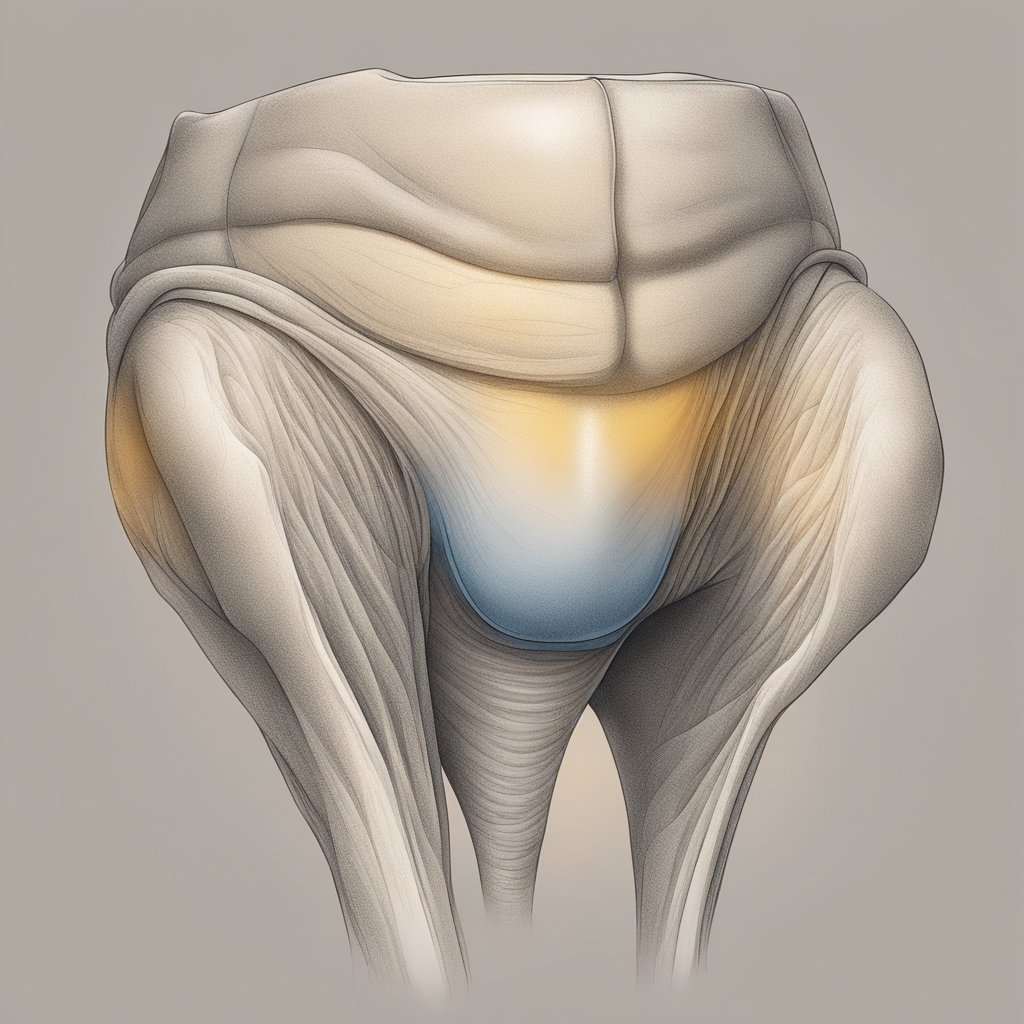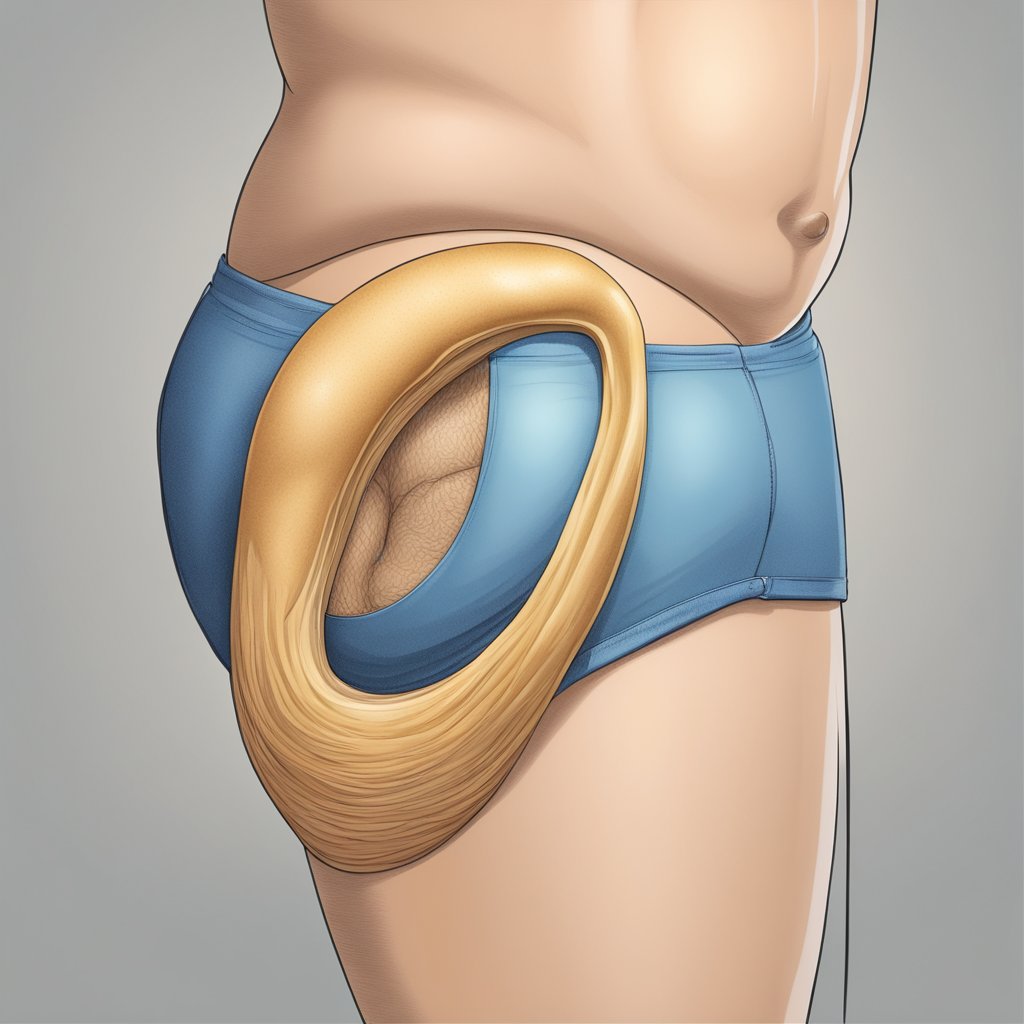Discovering a lump under the skin on your inner thigh can be a cause for concern; however, a lump without pus is not uncommon and can be indicative of a variety of underlying issues. These lumps might be soft or hard to the touch and may move easily under the skin or remain stationary. My intention in this article is to provide you with information on the potential causes, identification, and treatment options for such lumps, so that you can feel assured in understanding your symptoms and decide when professional medical advice is necessary.

While most skin lumps are benign, it’s important to monitor them for changes in size, shape, or sensation. Often, lumps are simply benign skin growths, cysts, lipomas, or could be associated with an infection or allergic reaction. Despite the lack of pus, which suggests a non-infectious origin, the characteristics and behavior of the lump provide valuable hints towards a diagnosis. If you see a lump developing, my advice is to take note of any other symptoms and consider the recent activities or changes in your health that may have contributed to its formation.
Key Takeaways
- Lumps without pus on the inner thigh may stem from various causes, including benign skin growths or reactions.
- Monitoring for changes in the lump and accompanying symptoms is crucial for determining its seriousness.
- Consulting with a healthcare provider is recommended for diagnosis and to discuss appropriate treatment options.
Possible Causes of Lumps on Inner Thigh

When examining a lump on the inner thigh, it’s important to consider various causes, ranging from skin infections to more serious conditions like cancer. I will explore these potential causes in detail to better understand what might be behind such lumps.
Skin Infections and Common Conditions
Skin infections caused by bacteria, viruses, or fungi can lead to the formation of lumps on the inner thigh. One common example is a boil, which results from an infected hair follicle. In addition, conditions like folliculitis, which is the inflammation of hair follicles, and hidradenitis suppurativa, a chronic skin condition characterized by small, painful lumps, can also manifest in this area.
- Boils: Infected hair follicles forming tender lumps
- Folliculitis: Inflamed hair follicles which may become lumpy
- Hidradenitis Suppurativa: Recurring lumps due to sweat gland inflammation
Benign Tumors and Cysts
Lumps on the inner thigh could also be due to benign growths such as lipomas, dermatofibromas, epidermoid cysts, sebaceous cysts, or ganglion cysts. These are usually non-cancerous:
- Lipomas: Soft, movable lumps made up of fat cells
- Dermatofibromas: Firm lumps consisting of fibrous tissue
- Epidermoid Cysts: Slow-growing lumps arising from the epidermis
- Sebaceous Cysts: Lumps stemming from blocked sebaceous glands
- Ganglion Cysts: Fluid-filled lumps often near joints or tendons
These types of lumps are generally not harmful but might require treatment if they become bothersome or painful.
Cancer-Related Concerns
Finally, while less common, lumps on the inner thigh can be cancerous lumps. Such cases necessitate professional medical evaluation. Any persistent or quickly growing lump should be assessed, as it might be a sign of a malignancy like sarcoma.
If I identify a lump that raises concern for cancer, immediate medical consultation becomes paramount. The presence of symptoms such as unexplained weight loss, a lingering fever, or a noticeable growth in the lump’s size could suggest cancerous developments.
Identifying Symptoms and When to See a Doctor
In my practice, I’ve observed that lumps under the skin on the inner thigh can vary widely in terms of symptoms and urgency. It’s crucial to recognize when a symptom warrants a professional evaluation.
Recognizing Symptoms of Concern
-
Symptoms: Look for a lump that is tender to touch or painful when pressure is applied.
-
Color and Texture: If the skin over the lump is red or inflamed, it indicates irritation or infection.
-
Size and Movement: Note any changes in size over time or if the lump feels fixed to the underlying tissue, which requires medical evaluation.
Signs Pointing to Urgent Medical Attention
-
Pain Level: Intense pain might suggest an underlying condition that requires prompt attention.
-
Fever and Swelling: Presence of fever or significant swelling could indicate an infection that necessitates immediate care.
-
Warmth and Inflammation: A lump that’s warm to the touch and continues to be inflamed signals the need for a doctor’s visit.
-
Abnormal Growth: Lumps that grow rapidly or have an unusual shape could be cancerous and should be assessed by a healthcare provider without delay.
Any persistent lumps on the inner thigh, especially those not associated with injury, could be a symptom of a deeper health issue. If I notice abnormalities such as these, I would promptly schedule an appointment with a doctor for a professional evaluation.
Examining and Diagnosing Skin Lumps
When I discover a lump under the skin on my inner thigh, it’s important I seek medical attention to determine the cause. I’ll need to understand the steps my healthcare provider will take to assess and diagnose the lump properly.
Initial Assessment by a Physician
My first step is to schedule an appointment with a doctor. During the visit, the doctor will inquire about my medical history and perform a physical examination of the lump. They will look at its size, shape, consistency, and whether it’s fixed or mobile. Here are some specific actions they might take:
- Inspection: Observing the color and texture of the surrounding skin.
- Palpation: Feeling the lump to assess its firmness and whether it’s painful.
If the lump’s characteristics or my symptoms suggest a more serious condition, the doctor may refer me to a specialist, such as a dermatologist.
Diagnostic Tests and Screening
After the initial assessment, if there’s still uncertainty about the diagnosis, my doctor might order further diagnostic tests. Here’s a brief outline of potential tests:
-
Imaging scans:
- Ultrasound: To view the lump in detail.
- MRI or CT scans: For a more comprehensive look, if needed.
-
Biopsy:
- A small sample of tissue is taken from the lump and analyzed for the presence of skin cancer or other abnormalities.
-
Blood tests:
- To check for infection or other underlying health issues that might cause the lump.
-
Dermatologist screening:
- If there is a possibility the lump could be skin cancer, a dermatologist will have the tools and expertise to conduct a thorough examination.
By undergoing these steps, I’ll have a clear understanding of what the lump is and how to proceed with treatment, if necessary. It’s crucial to follow through with the recommended screening and tests to ensure my health is not at risk.
Treatment Options for Different Types of Lumps
In my experience, it is crucial to assess the lump’s nature before considering treatment options. Whether a lump is benign or indicative of an infection can greatly influence the treatment approach.
Medical Treatments
For benign lumps such as lipomas or cysts that cause discomfort or grow progressively, I often recommend non-surgical medical treatments initially. If an infection is present, my approach includes:
- Antibiotics: I prescribe this when the lump is associated with a bacterial infection.
- Steroid Injections: These reduce inflammation and can shrink the lump if it’s not infected.
Surgical Procedures
Surgical intervention might be necessary, especially if the lump interferes with mobility or causes significant pain, even if it’s benign. My surgical recommendations include:
- Excision: I remove benign lumps completely through surgical excision to prevent recurrence.
- Drainage: If the lump forms a cyst that fills with fluid, I may perform drainage. This entails creating a small incision to release the fluid.
In every procedure, my focus is on the patient’s safety and the effectiveness of the treatment, tailoring my approach to their specific needs.
Prevention and Monitoring of Lumps
Maintaining certain lifestyle habits and being vigilant through regular check-ups can significantly reduce the risk of developing concerning lumps on the inner thigh and ensure early detection.
Lifestyle Recommendations
Preventive measures are key in reducing the risk of developing skin lumps. I recommend incorporating the following lifestyle changes that may help in prevention:
- Maintain a healthy weight: Excess body fat can increase hormone production, which might contribute to the formation of lumps.
- Balanced diet: A diet rich in fruits, vegetables, and lean proteins can support overall health and hormone balance.
- Hydration: Proper hydration is essential for maintaining skin and overall body health.
Risk factors that can be controlled through lifestyle include obesity and hormonal imbalances, which may be influenced by diet and physical activity.
Regular Check-ups and Self-Examination
I should seek regular check-ups with a healthcare provider, especially as aging can increase the likelihood of lumps due to changes in skin elasticity and hormone levels. A healthcare provider can offer professional insight into any changes to my skin and underlying tissues.
For self-examination:
- Frequency: It’s advised to perform self-examinations monthly.
- Method: Using the pads of my fingers, I should gently palpate my inner thighs for any new or changed lumps under the skin.
- Documentation: Noting the size, shape, and any other notable details can be important when discussing with a healthcare provider.
Keeping track of any skin changes and discussing these with my healthcare provider is crucial for early detection and management of any potential issues.
Frequently Asked Questions
In this section, I address common inquiries about lumps on the inner thigh under the skin, focusing on causes, identification, symptoms, and when to seek medical advice.
What could be the cause of a lump in the inner thigh near the groin area in females?
A lump in the inner thigh near the groin in females could be a swollen lymph node, a benign lipoma, a cyst, or an ingrown hair. Hormonal changes or infections might also cause such lumps.
How can one distinguish between a lipoma and other types of lumps on the inner thigh?
A lipoma is usually a soft, movable lump under the skin, which is typically not painful. It differs from other lumps that may be hard, fixed, or tender, indicating a different condition such as a cyst or lymph node.
What are the warning signs that a lump on the upper thigh near the groin needs medical attention?
Seek medical attention if the lump is rapidly growing, hard, immovable, painful, or if it’s accompanied by fever, weight loss, or changes in the skin above.
Are painful lumps on the inner thigh under the skin common and what might they indicate?
Painful lumps could suggest infections, abscesses, or cysts. They’re fairly common and often result from skin irritations, infections, or trauma.
Can sexually transmitted diseases manifest as bumps or lumps on the inner thigh?
Yes, sexually transmitted diseases like genital herpes, HPV, and syphilis can cause bumps or lumps in the inner thigh region, along with other symptoms.
When are painless lumps in the thigh muscle a reason for concern and what might they represent?
Painless lumps may be a cause for concern if they are growing, changing in texture, or causing other symptoms like muscular weakness. Such symptoms could indicate a benign tumor or, less commonly, a malignancy.